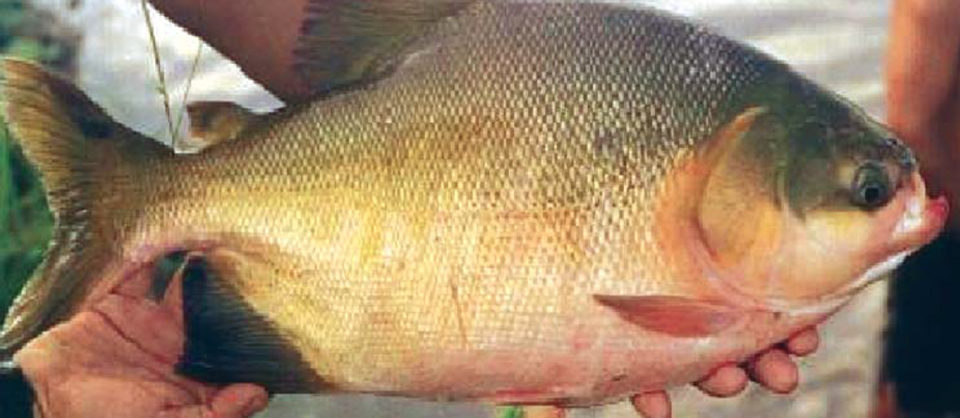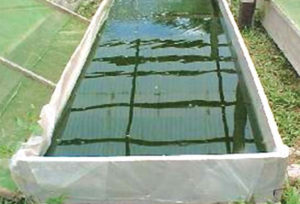Moina, known as the water flea, performs better than artemia

Commercial fisheries in the Amazon region have increased drastically in the last decade, and signs of overfishing of the most prominent fish species are apparent. Through concerted efforts by several Amazon institutions, particularly in Brazil and Peru, and foreign organizations, small- and large-scale fish culture now supplies part of the demand for most of these commercial species and helps preserve the fisheries.
Colossoma macropomum, commonly called black pacu in English, gamitana in Peru, and tambaqui in Brazil; and Piaractus brachypomus, red pacu in English, paco in Peru, and pirapitinga in Brazil, have excellent flesh quality, fast growth, and low protein requirements that make them suitable for aquaculture. As a consequence, fingerling demand for the fish has increased. Fingerling production in the Amazon must address the limited knowledge of alternative local food sources for larval and postlarval fish stages.
Larval feeding experiment

In a joint effort between Instituto de Investigaciones de la Amazonia Peruana and the Aquaculture Collaborative Research Support Program, the authors recently carried out a study to evaluate the growth performance of C. macropomum and P. brachypomus larvae fed artemia and Moina, a Cladoceran commonly known as the water flea. The study was funded in part by a U.S. Agency of International Development grant and conducted with support from the Pond Dynamics/Aquaculture Collaborative Research Support Program.
The study was conducted in a flow-through system consisting of 70-l aerated aquariums with three aquariums for each of three dietary treatments for the two species. Water quality was monitored throughout the larval-rearing process, with temperatures of 26 to 28 degrees-C, dissolved-oxygen concentrations of 5-6 milligrams per liter, and 6 to 7 pH.
Two days after yolk resorption, larvae were randomly distributed at 500 larvae per aquarium and conditioned for 10 days using plankton as feed. Thereafter, larvae were fed freshly hatched artemia nauplii, decapsulated artemia cysts, or Moina for four weeks at a ration below 8 percent body weight. Five larval samples were taken every week from each tank and fixed in buffered formalin for biometric measurements.
Survival
Mean survival for the C. macropomum larvae did not show significant differences between the diets, while P. brachypomus larvae showed greater survival with Moina, although all animals in one tank were lost to a Vibrio outbreak. In contrast, significant differences among C. macropomum and P. brachypomus larvae were determined for the final individual body weights.
Growth
Weight gains for the C. macropomum larvae were not significantly different among treatments, while growth for P. brachypomus larvae fed decapsulated artemia cysts or Moina was significantly higher (P = 0.078) than those fed artemia nauplii. The specific growth rates for C. macropomum and P. brachypomus larvae were not significantly different. Similarly, the condition factor was not significant for C. macropomum larvae, but higher for P. brachypomus larvae fed artemia cysts (Table 1).
Camargo, Performance of C. macropomum and P. brachypomus larvae fed varied experimental diets, Table 1
| Colossoma macropomum | Colossoma macropomum | Colossoma macropomum | Colossoma macropomum | Colossoma macropomum | Piaractus brachypomus | Piaractus brachypomus | Piaractus brachypomus | Piaractus brachypomus |
|---|
Colossoma macropomum | Colossoma macropomum | Colossoma macropomum | Colossoma macropomum | Colossoma macropomum | Piaractus brachypomus | Piaractus brachypomus | Piaractus brachypomus | Piaractus brachypomus |
|---|---|---|---|---|---|---|---|---|
| Artemia Cysts | 2.16 ± 0.76a | 177.85 ± 0.15a | 75.8 ± 13.8a | 33.8 ± 7.0a | 3.97 ± 0.47a | 770.00 ± 0.22a | 79.5 ± 7.9a | 36.5 ± 2.9a |
| Artemia Naupli | 2.17 ± 0.37a | 117.79 ± 0.11b | 71.7 ± 4.7a | 38.5 ± 1.8a | 3.00 ± 0.31b | 373.33 ± 0.13b | 64.1 ± 5.1b | 39.6 ± 2.3b |
| Moina | 2.40 ± 0.35a | 170.58 ± 0.11a | 73.7 ± 10.7a | 45.6 ± 6.6a | 3.58 ± 0.33b | 706.67 ± 0.23a | 76.2 ± 8.0a | 44.3 ± 2.8b |
Mouth opening
Initial mean mouth opening for 10-day-old C. macropomum larvae was 0.119 ± 0.02 cm, which represented 19.2 percent in relation to total body length, while initial mean mouth opening for 12-day-old P. brachypomus larvae was 0.173 ± 0.04 cm, or 21.8 percent in relation to total length. The mouth openings of C. macropomum and P. brachypomus larvae were large enough to consume Moina and both artemia live diets.
Overall results
On the whole, artemia cysts seemed to be a better feed than nauplii for P. brachypomus larvae. The reason could be the relative energy content of the nauplii. Energy content is higher in cysts, since no energy is invested in hatching, compared to 30 to 40 percent of energy invested in hatching artemia nauplii.
On the other hand, Moina and decapsulated artemia cysts are less evasive than artemia nauplii, thus increasing the chances for fish larvae to capture them with less energy. In general, Moina are a better live food source than artemia decapsulated cysts and nauplii. Moina is one of the most valuable food sources available because of its excellent high-protein nutritional profile, which is slightly higher than that of artemia.
(Editor’s Note: This article was originally published in the December 2005 print edition of the Global Aquaculture Advocate.)
Now that you've finished reading the article ...
… we hope you’ll consider supporting our mission to document the evolution of the global aquaculture industry and share our vast network of contributors’ expansive knowledge every week.
By becoming a Global Seafood Alliance member, you’re ensuring that all of the pre-competitive work we do through member benefits, resources and events can continue. Individual membership costs just $50 a year. GSA individual and corporate members receive complimentary access to a series of GOAL virtual events beginning in April. Join now.
Not a GSA member? Join us.
Authors
-
William N. Camargo
Southern Illinois University Fisheries and Illinois Aquaculture Center
Lincoln Drive, Life Science II
Room 173
Carbondale, Illinois 62901-6511 USA
-
Christopher C. Kohler
Southern Illinois University Fisheries and Illinois Aquaculture Center
Lincoln Drive, Life Science II
Room 173
Carbondale, Illinois 62901-6511 USA -
Susan T. Kohler
Southern Illinois University Fisheries and Illinois Aquaculture Center
Lincoln Drive, Life Science II
Room 173
Carbondale, Illinois 62901-6511 USA -
Melyna Silva P.
Southern Illinois University Fisheries and Illinois Aquaculture Center
Lincoln Drive, Life Science II
Room 173
Carbondale, Illinois 62901-6511 USA -
Fernando Alcántara B.
Instituto de Investigaciones de la Amazonía Peruana
Iquitos, Peru -
Cesar Sias A.
Instituto de Investigaciones de la Amazonía Peruana
Iquitos, Peru -
Palmira P. Padilla
Instituto de Investigaciones de la Amazonía Peruana
Iquitos, Peru
Tagged With
Related Posts

Health & Welfare
Aquaculture of Amazon fish in Latin America
Many fish species that live in the Amazon basin have great potential for aquaculture. The main species currently cultured in the region is tambaqui, a fast-growing, omnivorous fish that tolerates poor water quality.

Innovation & Investment
Aquaculture planning, development in Brazilian federal waters
The aquaculture industry in Brazil is moving toward further expansion with the support of the federal government. A key strategy of the More Fishing and Aquaculture plan is the development of aquaculture in federal waters. The plan promotes sustainable development of fisheries and aquaculture by linking those involved and consolidating state policies addressing social inclusion, security and food sovereignty. Tilapia is the main farmed fish, although tambaqui and others have potential for large-scale production due to their wide acceptance by consumers.

Responsibility
Brazil’s inland aquaculture
Freshwater fish culture is practiced in every state in Brazil, primarily at small-scale earthen pond facilities, but tilapia culture in reservoir cages is increasing.

Intelligence
Marine fish culture in Brazil
Marine fish farming in Brazil appears promising. A new cobia research network will support industry growth through standardization, development of technology and training.


